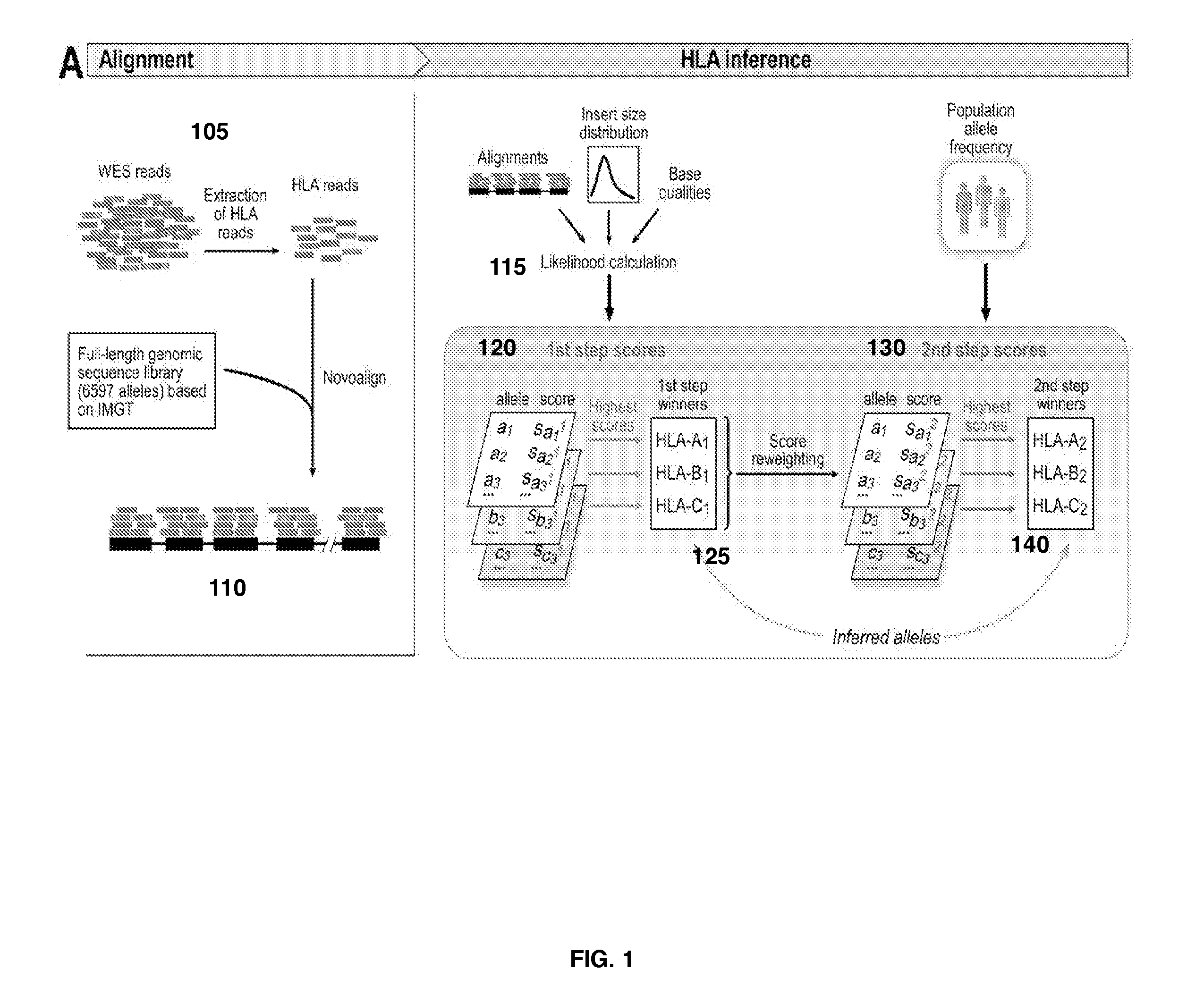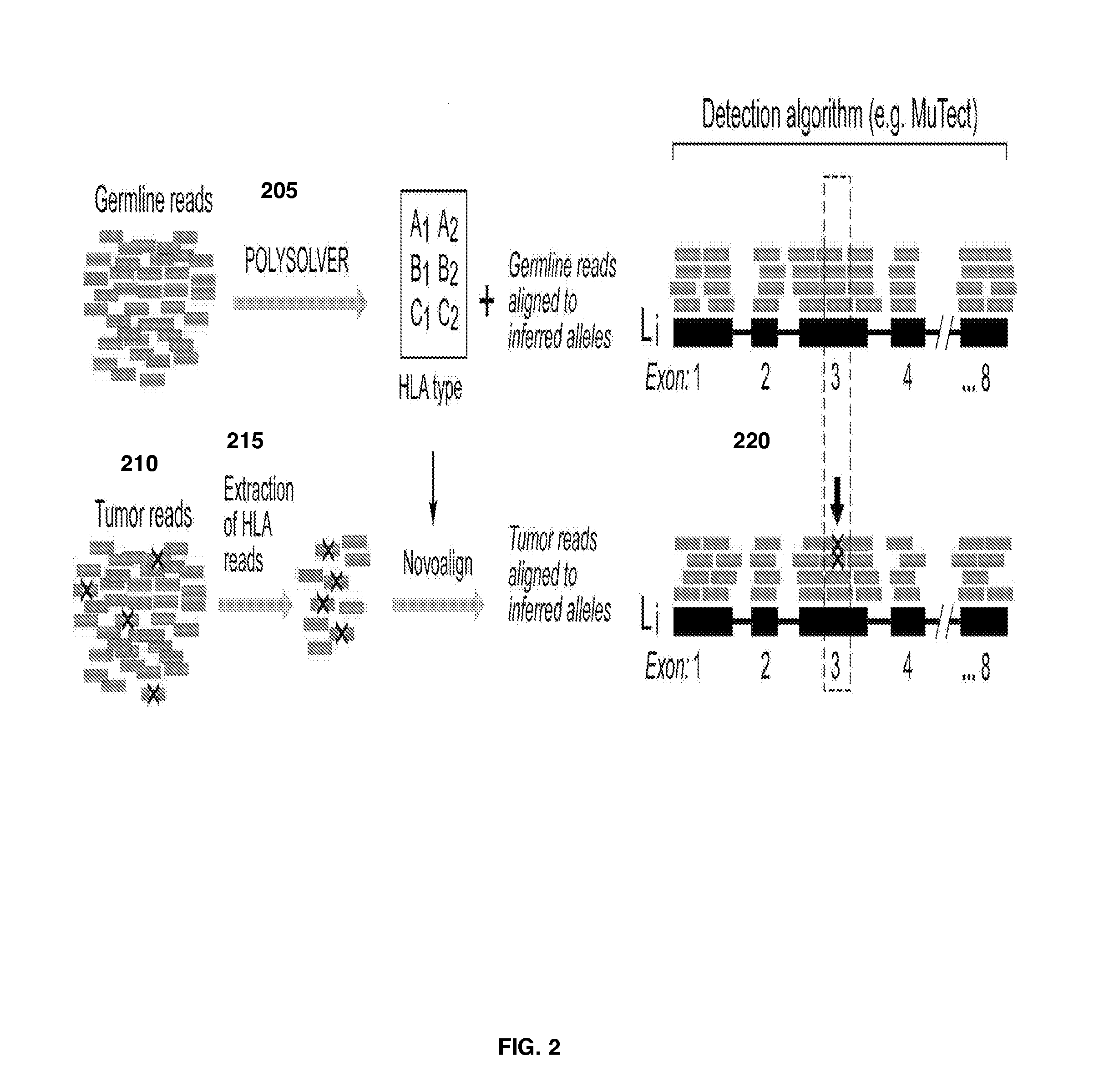Polymorphic gene typing and somatic change detection using sequencing data
a technology of somatic change and gene typing, applied in the field of gene typing and mutation detection of polymorphic genes using sequencing data, can solve the problems of increasing the difficulty of identifying near-identical alleles, laborious and expensive, and frequently appearing sequence ambiguities
- Summary
- Abstract
- Description
- Claims
- Application Information
AI Technical Summary
Benefits of technology
Problems solved by technology
Method used
Image
Examples
example processes
[0072]The example methods illustrated in FIG. 4-6 are described herein with respect to the components of the example operating environment 300. The example methods of FIG. 4-6 may also be performed with other systems and in other environments.
[0073]FIG. 4 is a block flow diagram depicting a method 400 to determine a polymorphic gene type of one or more polymorphic gene bases on whole exome sequencing data, in accordance with certain example embodiments.
[0074]Method 400 begins at block 405, wherein the alignment module 311 generates an alignment of gene reads from WES sequencing data that map to a gene reference sequence for the target gene. Block 405 will be described in further detail with reference to FIG. 5.
[0075]FIG. 5 is a block diagram depicting a method 405 to align reads from the WES sequence data with a gene reference set. The method 405 begins at block 505 where the alignment module 311 maps all the reads in the WES sequence data to a reference target gene sequence. The re...
example 1
[0125]WES from cases of chronic lymphocytic leukemia (CLL) patients has been previously reported (Landau et al., Cell. 2013, 152(4):714-26). A subset of cases within this cohort with available experimental HLA typing information (HLA-A, HLA-B, HLA-C) were selected for further analysis. A set of 133 HapMap samples comprising 15 Caucasians, 42 Black, 41 Chinese and 35 Japanese individuals with known HLA types (Erlich et al, 2011; www.1000genomes.org) was used as a validation set. For detection of somatic mutation of the HLA loci, the gene typing method described above was applied to data from 10 tumor types curated from the TCGA project including lung squamous, lung adenocarcinoma, bladder, head and neck, colon, rectum, uterine, glioblastoma, ovarian, and breast. Two additional data sets: a melanoma data set (Hodis et al. Cell. 2012, 150(2):251-63) and a chronic lymphocytic leukemia set (Wang et al., NEJM. 2011. 365:2497-2506), was also analyzed for mutations in the HLA-A, HLA-B and H...
example 2
Validation of Genotyping Method
[0132]The method disclosed herein was applied to WES data from a set of 133 HapMap samples with known HLA genotypes. 774 of 798 (97%) alleles from this validation set were correctly resolved at the protein level while allele groups were correctly typed in 787 of 798 (98.7%) instances All 42 homozygous alleles in this set were correctly identified, and no significant differences in performance were observed based on ethnicity or HLA gene (chi-squared test P-values 0.043 and 0.314 respectively, 95% Bonferroni corrected P-value threshold=0.025). See FIG. 9. However, when this method was applied to the HapMap samples without using population-level allele frequencies, only 89% accuracy was observed. To accommodate use of the method with samples of unknown ethnic origin, the following principal components (PC)-based method for exome-based ethnicity inference, which can be used prior to analysis by the genotyping method disclosed herein.
[0133]4-digit allele f...
PUM
| Property | Measurement | Unit |
|---|---|---|
| Fraction | aaaaa | aaaaa |
| Fraction | aaaaa | aaaaa |
| Size distribution | aaaaa | aaaaa |
Abstract
Description
Claims
Application Information
 Login to View More
Login to View More - R&D
- Intellectual Property
- Life Sciences
- Materials
- Tech Scout
- Unparalleled Data Quality
- Higher Quality Content
- 60% Fewer Hallucinations
Browse by: Latest US Patents, China's latest patents, Technical Efficacy Thesaurus, Application Domain, Technology Topic, Popular Technical Reports.
© 2025 PatSnap. All rights reserved.Legal|Privacy policy|Modern Slavery Act Transparency Statement|Sitemap|About US| Contact US: help@patsnap.com



